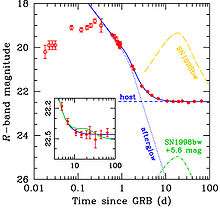GRB 060614
GRB 060614 was a gamma-ray burst detected by the Neil Gehrels Swift Observatory on June 14, 2006, with peculiar properties. It challenged a previously-held scientific consensus on gamma-ray burst progenitors[1] and black holes.[2]
 | |
| Other designations | GRB 060614 |
|---|---|
| Event type | Gamma-ray burst White hole (Hypothetical) |
| Date | 14 June 2006 |
| Duration | 102 ±1 second |
| Instrument | Neil Gehrels Swift Observatory |
| Constellation | Indus |
| Right ascension | 21h 23m 27.0s |
| Declination | −53° 02′ 02″ |
| Distance | 1,600,000,000 ly (490,000,000 pc) |
| Redshift | 0.125 ±0.001 |
| Source | [PBF2006d] Host Galaxy |
| Wikimedia Commons has media related to GRB 060614. |
| Wikinews has related news: |
Prior to this detection, it was believed that a long gamma-ray burst, like GRB 060614, was probably caused by gravitational collapse of a large star into a black hole, and would be accompanied by detectable supernova, whilst short gamma-ray bursts were thought to be the merger of two neutron stars.[3] However, the lack of any supernova and the vanishing spectral lags during GRB 060614 are typical of short GRBs, at odds with the long (102s) duration of this event and its origin in a galaxy 1.6 billion light years away in the constellation Indus.[4]
In December 2006, an article on the burst was published in the journal Nature, with the editors describing a hunt by scientists to define a new GRB classification system to account for this burst.[5] GRB 060614 was subsequently classified as a "hybrid gamma-ray burst", defined as a long burst without accompanying supernova, and was hypothesized to have been an observation of a white hole.[6]
References
- "Newfound diversity in gamma-ray bursts". UC Berkeley News. Retrieved 10 April 2019.
- "NASA Satellite Discovers New Kind of Black Hole Explosion". NASA. Retrieved 10 April 2019.
- "Hybrids in the Universe?". NASA. Retrieved 13 April 2019.
- Retter, Alon; Heller, Shlomo (2011). "The Revival of White Holes as Small Bangs". arXiv:1105.2776v1 [physics.gen-ph].
- "A new γ-ray burst classification scheme from GRB 060614". Nature (444): 1044–1046. 2006.
- Ratcliffe, Martin (February 2008). State of the Universe 2008 : new images, discoveries and events. Springer Science & Business Media. p. 57. ISBN 978-0-387-73998-4.